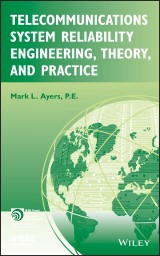Details

Telecommunications System Reliability Engineering, Theory, and Practice
IEEE Press Series on Networks and Service Management, Band 21 1. Aufl.
|
107,99 € |
|
| Verlag: | Wiley |
| Format: | EPUB |
| Veröffentl.: | 14.09.2012 |
| ISBN/EAN: | 9781118423141 |
| Sprache: | englisch |
| Anzahl Seiten: | 256 |
DRM-geschütztes eBook, Sie benötigen z.B. Adobe Digital Editions und eine Adobe ID zum Lesen.
Beschreibungen
<p><b>Practical tools for analyzing, calculating, and reporting availability, reliability, and maintainability metrics</b></p> <p>Engineers in the telecommunications industry must be able to quantify system reliability and availability metrics for use in service level agreements, system design decisions, and daily operations. Increasing system complexity and software dependence require new, more sophisticated tools for system modeling and metric calculation than those available in the current literature.</p> <p><i>Telecommunications System Reliability Engineering, Theory, and Practice</i> provides a background in reliability engineering theory as well as detailed sections discussing applications to fiber optic networks (earth station and space segment), microwave networks (long-haul, cellular backhaul and mobile wireless), satellite networks (teleport and VSAT), power systems (generators, commercial power and battery systems), facilities management, and software/firmware. Programming techniques and examples for simulation of the approaches presented are discussed throughout the book.</p> <p>This powerful resource:</p> <ul> <li>Acts as a comprehensive reference and textbook for analysis and design of highly reliable and available telecommunications systems</li> <li>Bridges the fields of system reliability theory, telecommunications system engineering, and computer programming</li> <li>Translates abstract reliability theory concepts into practical tools and techniques for technical managers, engineers and students</li> <li>Provides telecommunication engineers with a holistic understanding of system reliability theory, telecommunications system engineering, and reliability/risk analysis Telecommunications System Reliability Engineering, Theory, and Practice is a must-have guide for telecommunications engineers or engineering students planning to work in the field of telecommunications</li> </ul> <p><i>Telecommunications System Reliability Engineering, Theory, and Practice</i> is a must-have guide for telecommunications engineers or engineering students planning to work in the field of telecommunications.</p>
List of Illustrations vii <p>Preface xiii</p> <p>About the Author xv</p> <p>Acronym List xvii</p> <p>INTRODUCTION 1</p> <p><b>1 RELIABILITY THEORY 7</b></p> <p>1.1 System Metrics 8</p> <p>1.2 Statistical Distributions 18</p> <p>1.3 System Modeling Techniques 25</p> <p>1.4 Systems with Repair 33</p> <p>1.5 Markov Chain Models 35</p> <p>1.6 Practical Markov System Models 41</p> <p>1.7 Monte Carlo Simulation Models 47</p> <p>1.8 Repair Period Models 58</p> <p>1.9 Equipment Sparing 61</p> <p><b>2 FIBER-OPTIC NETWORKS 71</b></p> <p>2.1 Terrestrial Fiber-Optic Networks 71</p> <p>2.1 Submarine Fiber-Optic Networks 84</p> <p><b>3 MICROWAVE NETWORKS 95</b></p> <p>3.1 Long-Haul Microwave Networks 96</p> <p>3.2 Short-Haul Microwave Networks 117</p> <p>3.3 Local Area Microwave Networks 124</p> <p><b>4 SATELLITE NETWORKS 133</b></p> <p>4.1 Propagation 134</p> <p>4.2 Earth Stations 138</p> <p>4.3 VSAT Earth Stations 140</p> <p>4.4 Earth Stations 143</p> <p>4.5 Spacecraft 156</p> <p>4.6 Satellite Network Topologies 160</p> <p><b>5 MOBILE WIRELESS NETWORKS 171</b></p> <p>5.1 Mobile Wireless Equipment 172</p> <p>5.2 Mobile Wireless Network Systems 182</p> <p><b>6 TELECOMMUNICATIONS FACILITIES 187</b></p> <p>6.1 Power Systems 188</p> <p>6.2 Heating, Ventilation, and Air Conditioning Systems 207</p> <p><b>7 SOFTWARE AND FIRMWARE 213</b></p> <p>7.1 Software Failure Mechanisms 214</p> <p>7.2 Software Failure Rate Modeling 216</p> <p>7.3 Reliability and Availability of Systems with Software Components 220</p> <p>References 227</p> <p>Index 229</p>
<p>“For that reason, this book will be very useful for undergraduate students and practitioners who need a good introduction to, or a refresher on, the reliability aspects of the networks they work with.” (<i>Computing Reviews</i>, 14 January 2013)</p> <p>“This well-organized book compares and contrasts the reliabilities of corresponding components that make up today’s major networks as well as the reliability of facilities used to operate them.” (<i>Optics & Photonics News</i>, 1 November 2013)</p> <p> </p> <p> </p>
<p><b>MARK AYERS</b> is manager of RF Engineering at GCI Communications Corp headquartered in Anchorage, Alaska. He has a broad range of telecommunications experience in fiber optics, microwave radio, and satellite network design. Mr. Ayers holds a BS degree in mathematics from the University of Alaska Anchorage and an MS degree in electrical engineering from the University of Alaska Fairbanks. He is a registered Professional Electrical Engineer in the State of Alaska, a senior member in the IEEE, and teaches a variety of courses in the Engineering Department at the University of Alaska Anchorage.</p>
<p><b>Practical tools for analyzing, calculating, and reporting availability, reliability, and maintainability metrics</b></p> <p>Engineers in the telecommunications industry must be able to quantify system reliability and availability metrics for use in service level agreements, system design decisions, and daily operations. Increasing system complexity and software dependence require new, more sophisticated tools for system modeling and metric calculation than those available in the current literature.</p> <p><i>Telecommunications System Reliability Engineering, Theory, and Practice</i> provides a background in reliability engineering theory as well as detailed sections discussing applications to fiber optic networks (earth station and space segment), microwave networks (long-haul, cellular backhaul and mobile wireless), satellite networks (teleport and VSAT), power systems (generators, commercial power and battery systems), facilities management, and software/firmware. Programming techniques and examples for simulation of the approaches presented are discussed throughout the book.</p> <p>This powerful resource:</p> <ul> <li>Acts as a comprehensive reference and textbook for analysis and design of highly reliable and available telecommunications systems</li> <li>Bridges the fields of system reliability theory, telecommunications system engineering, and computer programming</li> <li>Translates abstract reliability theory concepts into practical tools and techniques for technical managers, engineers and students</li> <li>Provides telecommunication engineers with a holistic understanding of system reliability theory, telecommunications system engineering, and reliability/risk analysis Telecommunications System Reliability Engineering, Theory, and Practice is a must-have guide for telecommunications engineers or engineering students planning to work in the field of telecommunications</li> </ul> <p><i>Telecommunications System Reliability Engineering, Theory, and Practice</i> is a must-have guide for telecommunications engineers or engineering students planning to work in the field of telecommunications.</p>


















